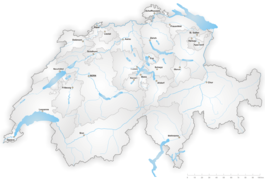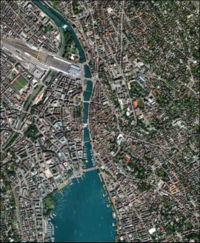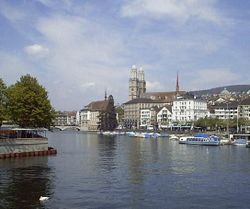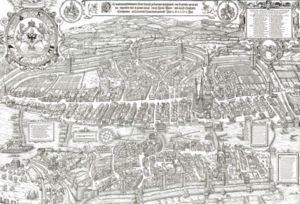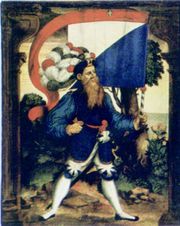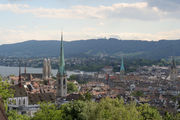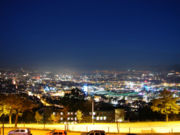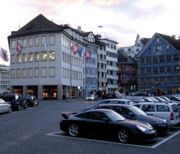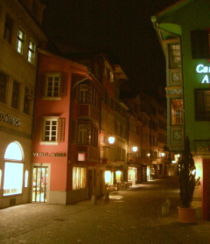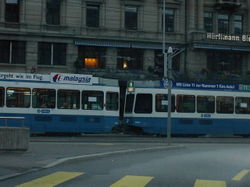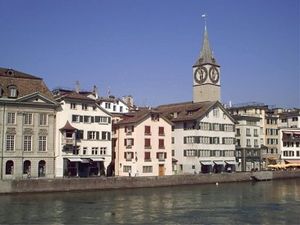Zürich
2007 Schools Wikipedia Selection. Related subjects: European Geography
Zürich (German: Zürich [ˈtsyːʁɪç], Zürich German: Züri [ˈtsyri], in English generally Zurich, Italian: Zurigo) is the largest city in Switzerland (population: 366,145 in 2004; population of urban area: 1,091,732) and capital of the canton of Zürich. The metropolitan population is around 1.3 million. The city is Switzerland's main commercial and cultural centre (the political capital of Switzerland being Bern), and is widely considered to be one of the world's global cities. According to a survey in 2006, it is the city with the best quality of life in the world.
The origin of the name is probably the Celtic word Turus, a corroborating reference to which was found on a tomb inscription dating from the Roman occupation in the 2nd century; the antique name of the town in its romanized form was Turicum.
Geography
The city is situated where the river Limmat leaves the northern end of Lake Zürich and is surrounded by wooded hills including (from the north) the Gubrist, the Hönggerberg, the Zürichberg, the Adlisberg and the Oettlisberg on the eastern shore; and the Uetliberg on the western shore. The river Sihl meets with the Limmat at the end of Platzspitz, which borders the Swiss National Museum (Landesmuseum). The geographic (and historic) centre of the city is the 'Lindenhof' a small natural hill on the left bank of the river Limmat, about 700 meters north of where the river leaves the Lake Zürich. Today the incorporated city stretches somewhat beyond it natural hydrographic confines given by its hills and includes some neighborhoods to the northeast in the Glattal (valley of the river Glatt).
History
In Roman times, Turicum was a tax-collecting point at the border of Gallia Belgica (from AD 90 Germania superior) and Raetia for goods trafficked on the Limmat river. A Carolingian castle, built on the site of the Roman castle by the grandson of Charlemagne, Louis the German, is mentioned in 835 ("in castro Turicino iuxta fluvium Lindemaci"). Louis also founded the Fraumünster abbey in 853 for his daughter Hildegard. He endowed the Benedictine convent with the lands of Zürich, Uri, and the Albis forest, and granted the convent immunity, placing it under his direct authority.
In 1045, King Henry III granted the convent the right to hold markets, collect tolls, and mint coins, and thus effectively made the abbess the ruler of the city.
Zürich became reichsunmittelbar in 1218 with the extinction of the main line of the Zähringer family. A city wall was built during the 1230s, enclosing 38 hectares. Emperor Frederick II promoted the abbess of the Fraumünster to the rank of a duchess in 1234. The abbess assigned the mayor, and she frequently delegated the minting of coins to citizens of the city. However, the political power of the convent slowly waned in the 14th century, beginning with the establishment of the Zunftordnung ( guild laws) in 1336 by Rudolf Brun, who also became the first independent mayor, i.e. not assigned by the abbess.
Zürich joined the Swiss confederation (which at that time was a loose confederation of de facto independent states) as the fifth member in 1351. Zürich was expelled from the confederation in 1440 due to a war with the other member states over the territory of Toggenburg (the Old Zürich War). Zürich was defeated in 1446, and re-admitted to the confederation in 1450.
Zwingli started the Swiss reformation at the time when he was the main preacher in Zürich. He lived there from 1484 until his death in 1531.
In 1839, the city had to yield to the demands of its rural subjects, following the Züriputsch of 6 September. Most of the ramparts built in the 17th century were torn down, without ever having been sieged, to allay rural concerns over the city's hegemony. The Treaty of Zurich between Austria, France, and Sardinia was signed in 1859.
From 1847, the Spanisch-Brötli-Bahn, the first railway on Swiss territory, connected Zürich with Baden, putting the Zürich Main Station at the origin of the Swiss rail network. The present building of the Hauptbahnhof (chief railway station) dates to 1871.
Coat of arms
The blue and white coat of arms of Zürich is attested from 1389, and was derived from banners with blue and white stripes in use since 1315. The first certain testimony of banners with the same design is from 1434. The coat of arms is flanked by two lions. The red Schwenkel on top of the banner had varying interpretations: For the people of Zürich, it was a mark of honour, granted by Rudolph I. Zürich's neighbors mocked it as a sign of shame, commemorating the loss of the banner at Winterthur in 1292. Today, the Canton of Zürich uses the same coat of arms as the city.
Sights
Churches
- Grossmünster (great minster) (near Lake Zürich, in the old city), where Zwingli was pastor; first building around 820; declared by Charlemagne imperial church
- Fraumünster (our lady's minster) first church built before 874; the Romanesque choir dates from 1250-70; Marc Chagall stained glass choir windows; (on the opposite side of the Limmat). During 2004 the Fraumünster was fully renovated. During this period the installed scaffolding went above the tip of the tower allowing a unique and exceptional 360° panoramic view of Zürich.
- St. Peter (downstream from the Fraumünster, in the old city); with the largest clock face in Europe
Museums
- Museum Bärengasse, history of the city in the 18th century
- Kunsthaus Zürich, one of the largest collections in Classic Modern Art in the world (Munch, Picasso, Braque, Giacometti, etc.)
- Museum Rietberg, Antique Asian Art
- Museum Bellerive, Museum for fashion, architecture and design , located in a villa on the beach of the lake
- Kunsthalle Zürich
- Migros Museum, modern and avantgarde international Art.
- Museum of Design Zürich
- Swiss National Museum (Landesmuseum) , located in the Platzspitz park opposit the main station
- Johann Jacobs Museum, history of colonial Fine Food and coffee
- Johanna Spyri Museum
- Haus Konstruktiv , constructive, concrete and conceptual art and design
- NONAM North American Native Museum
- Museum of the History of Medicine
Other sights
- Lindenhof near St. Peter; site of the Roman and medieval castle. V
- Guild houses along the river (downstream from the Grossmünster)
- Old town (Altstadt), District 1, on both sides of the river
- Bahnhofstrasse, Zürich (shopping avenue) starting at main train station
- Parade-Platz, Plaza in the middle of Bahnhofstrasse, Zürich, centre of financial activity, with world-headquarters of several Swiss banks: UBS and Credit Suisse.
- Zoological garden
- Masoala Rainforest Ecosystem Great Glass Hall in the Zoological garden with trees, flowers and animals in liberty from the rainforest of Masoala National Park in Madagascar
- Botanical Garden of the University of Zürich
- Chinese Garden, Zürich
- Neu Oerlikon, part of City District Zürich Oerlikon: north quarter of the city - Oerliker Park, MFO-Park, Centre-11-Building, Price-Waterhouse-Building, ABB-Building, UBS-Building and other modern public spaces.
- Lake Zürich, running from Zürich to Rapperswil and linking with the Obersee
- Üetliberg, at an altitude 813 metres above sea level, with Uetlibergturm TV-tower
- Fluntern Cemetery
Industry and commerce
UBS, Credit Suisse, Swiss Re, and many other financial institutions have their headquarters in Zürich, the commercial centre of Switzerland. Zürich is the world's primary centre for offshore banking, mainly due to Swiss bank secrecy. The financial sector accounts for about one quarter of the city's economic activities. The Swiss Stock Exchange has its headquarters in Zürich (see also Swiss banking).
Business
Zürich is a leading financial centre and has repeatedly been proclaimed the global city with the best quality of life anywhere in the world. The Greater Zürich Area is Switzerland’s economic centre and home to a vast number of international companies. The GDP of the Zürich Area is CHF 210 billion (USD 160 billion) or CHF 58'000 (USD 45'000) per capita (2005).
Economic success reasons
The success of the Greater Zürich Economic Area as one of the most important in the world is probably due to more than one factor. The very low tax rate and the possibility for foreign companies and private persons to optimize their tax burden by personalized tax agreement with the Tax Authorities is surely one of the key points - a practice that often brings conflicts with Switzerland's neighbours in Europe, who do not like this type of successful and aggressive strategy for establishing European headquarters or service/research centres by known global economic players (e.g. IBM, General Motors Europe, Google, Microsoft, Pfizer). The fact that Switzerland doesn't have an inheritance tax is also an important factor for rich private persons.
Another reason for the economic success of Zürich can be seen in the research and educational (R&D) field of the city. The ETH Zurich is ranked alongside the University of Zurich: there are more than 58,000 students. The reservoir for qualified employees is therefore impressive.
Other data: Switzerland made an excellent showing in the IMD World Competitiveness Yearbook 2005, scoring in the Top 10 in the following categories:
- Nobel Prizes per resident (No.2)
- Active patents per resident (No.2)
- Private research expenditure (No.6)
- R&D expenditure per resident (No.6)
- R&D employees per resident (No.8)
- R&D expenditure as % of the GNP (No.10)
Most of the Swiss R&D institutions are concentrated in the Zürich area.
Of course also the quality of life is very important in the possible reasons for the international economic growth. William M. Mercer, an HR consulting firm based in London, has ranked Zürich as the city with the highest quality of life anywhere in the world for the fourth consecutive time. Berne and Geneva were also ranked among the Top 10 – in fact, Switzerland was the only country with more than one city in the Top 10.
Thanks to extremely low crime rates, personal safety can be assured without extra charges. And the importance of security as an economic factor should not be underestimated.
The Swiss stock exchange
The Swiss stock exchange is called SWX Swiss Exchange. The SWX is the head group of several different worldwide operative financial systems: virt-x, Eurex, Eurex US, EXFEED and STOXX. The exchange turnover generated at the SWX was in 2004 of 1,244,045 million CHF; the number of transactions arrived in the same period at 14,697,381 and the Swiss Performance Index (SPI) arrived at a total market capitalisation of 780,320 million CHF.
The SWX Swiss Exchange goes back more than 150 years. In 1996, fully electronic trading replaced the traditional floor trading system at the stock exchanges of Geneva (founded in 1850), Zurich (1873) and Basle (1876).
The SWX is subject to Swiss law. The Federal Act on Stock Exchanges and Securities Trading (SESTA) prescribes the concept of self-regulation, which obligates the SWX to meet international standards in its regulatory activities. The SWX itself is supervised by the Swiss Federal Banking Commission (SFBC).
The shares traded on SWX are mainly held in the Swiss-based accounts of domestic and international investors. Other products traded on the SWX Platform are bonds (CHF-denominated bonds as well as international bonds), traditional investments, Exchange Traded Funds (ETFs, known as exchange-traded index funds) and non-standardised derivatives. In terms of turnover, the SWX Swiss Exchange operates Europe's largest market segment for listed and exchange-traded warrants.
Chairman of the Board of Directors of the SWX Group is Prof. Dr. Peter Gomez. Gomez is a business professor at St. Gallen business school.
Education and research
- ETH Zürich
- University of Zürich
- IBM Zürich Research Laboratory
- Swiss Re's Centre for Global Dialogue
- SIK Swiss Institute for Art Research - Schweizerisches Institut für Kunstwissenschaften
- HGKZ - University of Applied Sciences and Designs
- Avenir Suisse - Liberal Think Tank
- Swiss Institute of International Studies
- HMT School of Music, Drama and Dance - Hochschule für Musik und Theatre
- ZFH College of Applied Sciences and Technologies Zurich - Zürcher Fachhochschule
- Graduate School of Business Administration Zurich
- National Centre of Competence in Research - Financial Valuation and Risk Management
- Inter-Community School Zurich
- Zurich International School
Sports
- Grasshopper-Club Zürich Football (German)
- ZSC Lions Ice Hockey Club (German)
- FC Zürich Football Club (German)
- Challengers Baseball Club Zürich
- Zürich Lions Baseball Club
- Zürich Renegades American Football Club (German)
- Federation Internationale de Football Association (FIFA) headquarters.
- Weltklasse Zürich
- International Ice Hockey Federation (IIHF)
- Swimming in the lake, in the river or in several outdoor swimming pools (June-September)
Events
- Street Parade
- Sechseläuten, spring festival of the guilds and burning of the Böögg
- Zurich International Theater Festival - Zürcher Theatre Spektakel, it ranks among the most important European festivals for the contemporary performing arts.
- Kunst Zürich, international art fair with an annual guest city (New York in 2005); combines most recent and youngest art with the works of well-established artists.
- Annual public art program each summer, sponsored by the Zürich City Association (the local equivalent of a chamber of commerce) with the cooperation of the city government. The theme for 2005 was teddy bears.
- Weltklasse Zürich, anually in August www.weltklasse.ch
- freestyle.ch, one of the biggest freestyle events in europe, www.freestyle.ch
Transportation
Zürich is a hub for rail, road, and air traffic. It has several railway stations, including Zürich Main Station, Zürich Oerlikon, Zürich Stadelhofen, and Zürich Altstetten. The Cisalpino, InterCity Express, and even the TGV high-speed trains stop in Zürich.
The A1, A3 and A4 motorways pass close to Zürich. The A1 heads west towards Bern and Geneva and eastwards towards St. Gallen; the A4 leads northwards to Schaffhausen; and the A3 heads northwest towards Basel and southeast along Lake Zurich and Lake Walen towards Sargans.
Zürich has a major international airport at Kloten, less than 10 kilometres northeast of the city. There is also an airfield in Dübendorf, although it is not used for civil aviation.
Within Zürich and throughout the canton of Zürich, the ZVV network of public transport has traffic density rating among the highest worldwide. If you add frequency, which in Zürich can be as often as 7 minutes, it does become the densest across all dimensions. Three means of mass-transit exist: the S-Bahn (local trains), trams, and buses (both diesel and electric, also called trolley buses). Rumour has it that no point exists on the ground floor within the central district which is farther than 150 metres from the next bus, tram, or train stop.
In addition the public transport network includes boats on the lake and river, funicular railways and even a cable car between Adliswil and Felsenegg. Tickets purchased for a trip are valid on all means of public transportation (train, tram, bus, boat).
Notable people
People who were born or died in Zürich:
- Huldrych Zwingli ( 1484 - 1531), reformer
- Conrad Gessner ( 1516 - 1565), naturalist, born and died in Zürich
- Johann Jakob Scheuchzer ( 1672 - 1733), scholar, born in Zürich
- Johann Kaspar Lavater ( 1741 - 1801), poet and physiognomist, born in Zürich
- Johann Heinrich Pestalozzi ( 1746 - 1827), educational reformer, born in Zürich
- James Sadleir (c. 1815 - 1881), fugitive swindler, murdered in Zürich
- Gottfried Keller ( 1819 - 1890), poet, born and died in Zürich
- Conrad Ferdinand Meyer ( 1825 - 1898), poet, born in Zürich
- Johanna Spyri ( 1827 - 1901), author of Heidi, died in Zürich
- Grand Duchess Marie Alexandrovna of Russia ( 1853) - ( 1920) Duchess of Edinburgh, died in Zürich
- Wilhelm Filchner ( 1877 - 1957), explorer, died in Zürich
- James Joyce ( 1882 - 1941), Irish novelist, died in Zürich (buried at Fluntern cemetery in Zürich)
- Pancho Vladigerov ( 1899 - 1978), Bulgarian composer, born in Zürich
- Felix Bloch ( 1905 - 1983), physicist, born in Zürich
- Elias Canetti ( 1905 - 1994), novelist, died in Zürich
- Max Frisch ( 1911 - 1991), novelist, born and died in Zürich
- Hugo Koblet ( 1925 - 1964), cycling champion
- Bruno Ganz (born 1941), actor, born in Zürich
- Martin Suter (born 1948), author, born in Zürich
- Lucinda Ruh (born 1979), figure skater, born in Zürich
- Heinz Gunthardt (born 1959), professional tennis player, born in Zürich
Famous residents:
- Tristan Tzara ( 1915- 1919)
- Richard Wagner ( 1849– 1861)
- Albert Einstein ( 1896– 1900, 1909– 1911, 1912– 1914)
- Vladimir Lenin ( 1917)
- Thomas Mann ( 1933– 1942)
- Kurt Tucholsky ( 1932– 1933)
- James Joyce ( 1915– 1919)
- Harald Naegeli
- Tina Turner
- Elisabeth Schwarzkopf
- Andreas Vollenweider
- Moritz Leuenberger
- Kimi Räikkönen
- Fernando Alonso
- Yves Netzhammer
See also: List of mayors of Zürich
Hotels
- Savoy Baur en Ville ( )
- Baur au Lac ( )
- Dolder ( )
- Alden Splügenschloss ( )
- Eden au Lac ( )
- Park Hyatt Zürich ( )
- Widder ( )
- Marriott ( )
- Ascot ( )
- Swissotel ( )
Map Overview: Hotels in Zurich
See also: Zürich Tourismus
Sister cities
- San Francisco, United States (private initiative)
- Kunming, Peoples Republic of China

